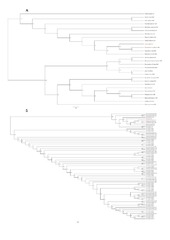| dc.description.abstract | Background: The life cycle of many animals includes a larval stage, which has diversified into an astonishing variety of ecological strategies. The Nemertea is a group of spiralians that exhibits a broad diversity of larval forms, including the iconic pilidium. A pelagic planktotrophic pilidium is the ancestral form in the Pilidiophora, but several lineages exhibit deviations of this condition, mostly as a transition to pelagic lecithotrophy. The most extreme case occurs, however, in the Pilidiophoran Lineus ruber, which exhibits an adelphophagic intracapsular pilidium, the so-called Schmidt’s larva. Results: We combined confocal laser scanning microscopy and gene expression studies to characterize the development and metamorphosis of the Schmidt’s larva of L. ruber. The larva forms after gastrulation, and comprises a thin epidermis, a proboscis rudiment and two pairs of imaginal discs from which the juvenile will develop. The cells internalized during gastrulation form a blind gut and the blastopore gives rise to the mouth of the larva and juvenile. The Schmidt’s larva eats other siblings that occupy the same egg capsule, accumulating nutrients for the juvenile. A gradual metamorphosis involves the differentiation of the juvenile cell types from the imaginal discs and the shedding of the larval epidermis. The expression of evolutionarily conserved anterior (foxQ2, six3/6, gsc, otx), endomesodermal (foxA, GATA456-a, twi-a) and posterior (evx, cdx) markers demonstrate that the juvenile retains the molecular patterning of the Schmidt’s larva. After metamorphosis, the juveniles stay over 20 days within the egg masses, until they are fully mature and hatch. Conclusions: The evolution of the intracapsular Schmidt’s larva involved the loss of the typical feeding structures of the planktotrophic pilidium and a precocious formation of the imaginal discs, as also observed in other pelagic lecithotrophic forms. However, no special adaptations are observed related to adelphophagy. As in planktotrophic pilidium, the molecular mechanism patterning the juvenile is only active in the imaginal discs and not during the early development of the larva, suggesting two separate molecular programs during nemertean embryogenesis. Our results illuminate the diversification of larval forms in the Pilidiophora and Nemertea, and thus on the developmental mechanisms underlying metazoan larval evolution. | en_US |





